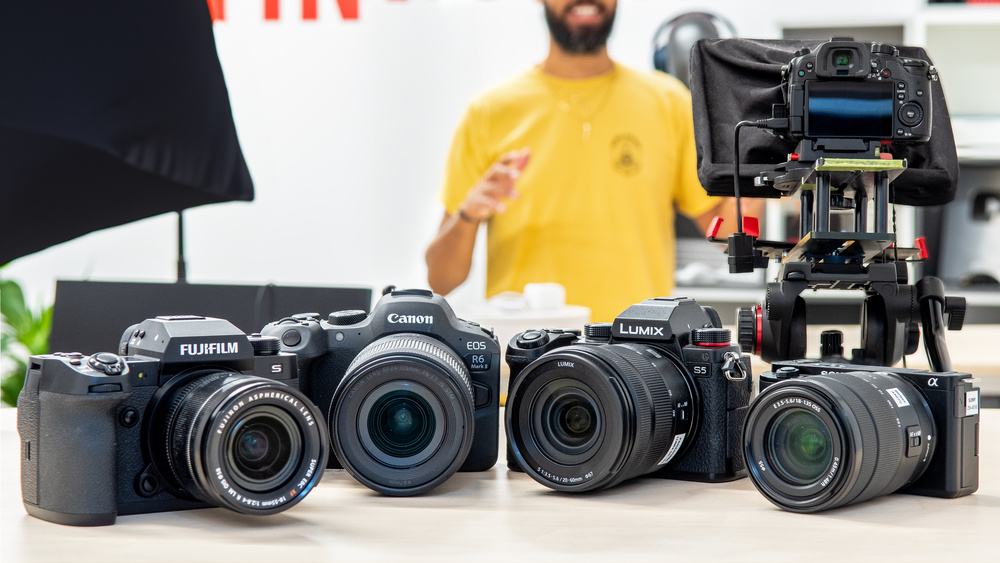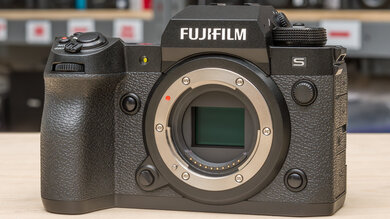
Investing in a mirrorless or DSLR camera is an increasingly viable option for amateur filmmakers who want to produce high-quality videos without spending a fortune on professional video gear. In fact, consumer stills and hybrid cameras are becoming increasingly capable video cameras, with many supporting internal 10-bit recording and a wide range of recording formats, codecs, and picture profiles. Generally speaking, when looking for a filmmaking camera, you should consider the camera's video resolution and frame rate options, whether or not it has in-body image stabilization (IBIS), and design features like dual memory card slots and ports to attach peripherals like microphones or external recorders. Of course, budget and ergonomic preferences also play a big role in determining which camera is best for you.
We don't currently test cinema cameras, and because dedicated cinema cameras run the gamut from affordable prosumer models to astronomically expensive professional models, this article focuses primarily on consumer stills and hybrid cameras with advanced video features for those looking to get started shooting films. Note also that your chosen lens will significantly affect your camera's performance, including its stabilization and autofocus performance.
We've bought and tested over 95 cameras in our lab, and below, you'll find our recommendations for the best hybrid cameras for aspiring filmmakers and videographers to buy. If you're looking for a simpler, more affordable camera to create videos for online media platforms, check out our recommendations for the best cameras for YouTube. Otherwise, see our list of the best 4k cameras for the best 4k-capable cameras we've tested or our best cameras overall.
-
Best Camera For Videography
Studio VideoSensor SizeAPS-CIn-Body Image StabilizationYesMirrorlessYesBody TypeSLR-StyleThe Fujifilm X-H2S is one of the best hybrid cameras in its price range for up-and-coming videographers. It's an incredibly capable camera, with a 26-megapixel stacked sensor that keeps rolling shutter to a minimum and supports 6.2k open gate recording. It's also one of the few consumer cameras that can record video from a 14-bit readout, meaning you'll get a wider dynamic and tonal range. On top of that, it records at up to 60 fps in 4k without a crop and even has a slow-motion recording mode that captures 4k at 120 fps.
Aside from its superb internal recording capabilities, it also has all the ports you'll need for video peripherals, including a full-sized HDMI port to connect a compatible external recorder, to which you can output RAW video. Even without an external recorder, the camera's internal codec support is fantastic, with Apple ProRes formats to capture higher-quality video with less compression. Really, that's just scratching the surface of what this camera can do, making it one of the best-value options for hybrid and video shooters.
-
Best Upper Mid-Range Camera For Videography
Studio VideoSensor SizeFull FrameIn-Body Image StabilizationYesMirrorlessYesBody TypeSLR-StyleIf the Fujifilm X-H2S is out of your price range, the Panasonic LUMIX S5 offers fantastic bang for your buck and can often be found on sale now that the Panasonic LUMIX DC-S5 II has replaced it. Although there's a significant crop at 60 fps, the camera can record 4k video at up to 60 fps, with internal 10-bit recording and a wide range of codecs and recording formats. Video quality from its full-frame sensor is also excellent, and its in-body image stabilization (IBIS) works very well.
That said, its contrast-based autofocus isn't nearly as good as other options on the market, including the X-H2S above, but if you use manual focus anyway, this is a steal of a camera. If autofocus is important to you, the S5 Mark II has upgraded to a phase-detection autofocus system, but it'll cost you more. It's also worth noting that native L-mount lenses can be expensive, though you can get around that by going for third-party options or using a lens-mount adapter.
-
Best Mid-Range Camera For Videography
Studio VideoSensor Size4/3 (MFT)In-Body Image StabilizationYesMirrorlessYesBody TypeSLR-StyleAnother great option for aspiring filmmakers is the Panasonic LUMIX GH5 II. It uses a Micro Four Thirds (M4/3) sensor instead of a full-frame sensor like the Panasonic LUMIX S5 above, so while it's a bit less suited to shooting in dim or uncontrolled lighting conditions, it still delivers excellent video quality overall. Plus, you'll find a lot more affordable and portable lens options for the Four Thirds system.
Like its full-frame sibling, the GH5 II supports many resolution and frame rate options, including anamorphic modes to get a wider, more cinematic aspect ratio and UHD and DCI 4k at up to 60 fps. You also get Log profiles and 10-bit 4:2:2 4k recording (up to 30 fps) to capture more color information and give you more flexibility in post-production. The GH5 II has since been replaced by the Panasonic LUMIX GH6, which has a higher-resolution sensor, higher-resolution video recording, and a CFexpress card slot. But, for the price, the GH5 II is still one of the best cameras for filmmaking that you can get.
-
Best Budget Camera For Videography
Studio VideoSensor SizeAPS-CIn-Body Image StabilizationNoMirrorlessYesBody TypeSLR-StyleThe Sony ZV-E10 is the best camera for filmmaking on a budget. Though marketed as a vlogging camera, this entry-level APS-C model offers a lot for beginner videographers and filmmakers who don't want to spend a fortune on camera gear. It doesn't have a viewfinder like the cameras above, but the fully articulated screen is perfect for video work. The camera's portable size also makes it a breeze to shoot anywhere. Unfortunately, it doesn't have IBIS, but you can pair it with optically stabilized lenses or use a video rig to get smoother camera movements. It also has excellent connectivity options, with headphone and mic jacks and a Micro HDMI port to connect an external monitor.
There's no time limit on recording, which is great for longer recording sessions. Its battery life is also impressive, and you're unlikely to have any issues with overheating. Compared to higher-end options, though, you'll miss out on 10-bit internal recording and 60 fps 4k video. However, you still get 4k at up to 30 fps and 1080p at up to 120 fps for slow-motion recording. Overall, it's a great choice for the budget-conscious filmmaker.
-
Best Camera For Low-Light Videography
Studio VideoSensor SizeFull FrameIn-Body Image StabilizationYesMirrorlessYesBody TypeSLR-StyleThe Sony ZV-E1 is one of the best cameras for videography in low light. That's because it features a 12 MP full-frame sensor optimized for low-light shooting—the same sensor found in the pricier Sony α7S III and Sony FX3, some of the best videography cameras in their respective classes. With fantastic noise handling and plenty of dynamic range, the ZV-E1 delivers excellent video quality in even the trickiest lighting conditions. It also comes with in-body image stabilization, Sony's ever-reliable autofocus, and 4k recording at up to 60 fps.
The Panasonic LUMIX GH5s is another great option for low-light videography. Though it uses a smaller Four Thirds sensor, the sensor's low resolution and dual-native ISO are designed to optimize the camera for low light, and the camera supports a wide array of recording formats and codecs. It's a more portable camera system than the ZV-E1, with more compact lens options and more effective IBIS, but its AF falls far behind the Sony camera's. But if you prefer manual focus, the GH5s is a good choice to save you some money. Otherwise, the ZV-E1 offers a ton of value for its price for solo operators who frequently shoot in uncontrolled or dim lighting conditions.
Notable Mentions
- Canon EOS R6 Mark II: The Canon EOS R6 Mark II is an excellent full-frame option for filmmakers. It supports internal 10-bit 4:2:2 recording in 4k at up to 60 fps but doesn't offer as many recording formats and codecs as the Fujifilm X-H2S and has worse rolling shutter effect. See our review
- Fujifilm X-T4: The Fujifilm X-T4 is an excellent upper mid-range option for hybrid shooters, with 4k recording at up to 60 fps. While its APS-C sensor is better suited to low light than the Panasonic LUMIX GH5 II, it has fewer recording format/codec options and is limited to 4:2:0 subsampling internally. See our review
- SIGMA fp L: The SIGMA fp L is a unique full-frame camera with a compact, modular design. It supports many recording formats, including 12-bit CinemaDNG RAW, and has many cinema features. However, its modular design takes some time to get used to and potentially means additional costs compared to a more traditional camera like the Fujifilm X-H2S. It also has a sub-par autofocus system and can't record 4k / 60 fps. See our review
- Sony α7 IV: The Sony α7 IV is another fantastic hybrid option with advanced video specs. However, it can only record 4k / 60 fps video with a Super35 crop and, unlike the Fujifilm X-H2S, it can't output RAW video. See our review
Recent Updates
-
Aug 23, 2023: Checked that picks were still relevant and up to date.
-
Jul 27, 2023: Removed the Canon EOS R7, shifted the Panasonic LUMIX GH5 II to the 'Mid-Range' spot, and added the Panasonic LUMIX DC-S5 as the 'Upper Mid-Range' pick. Also replaced the Panasonic LUMIX GH5s with the Sony ZV-E1 as the 'Low Light' pick.
-
Jun 29, 2023: Moved the Canon EOS R6 Mark II to Notable Mentions and replaced it with the Fujifilm X-H2S as the 'Best Camera For Filmmaking'.
All Reviews
Our recommendations above are what we think are currently the best filmmaking cameras for most people to buy, according to their needs. We factor in the price, feedback from our visitors, and availability (no cameras that are difficult to find or almost out of stock in the U.S.).
If you would like to choose for yourself, here's the list of all our reviews for video-capable cameras. Be careful not to get caught up in the details. There is no single perfect camera. Personal taste, preference, and shooting habits will matter more in your selection.
























